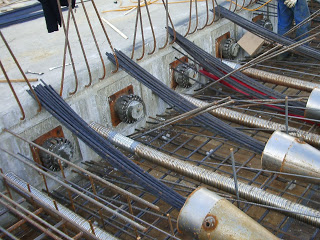Saad Iqbal | 🗓️Modified: February 23, 2016 | ⏳Read Time: 3 min | 👁Post Views: 988
Prestressing is now a must-to-have phenomenon in every mega project whether it includes flyovers or dam or whatever. During the design procedures a very important question that arises in the mind of the engineer is; whether to use jacking at one end only or from both ends.
 |
| Jacking at one end or both ends |
The answer to this question lies and depend on some of the features of the project.
During prestressing operation at one end, frictional losses will occur and the prestressing force decreases along the length of tendon until reaching the other end. These frictional losses include the friction induced due to a change of curvature of tendon duct and also the wobble effect due to deviation of duct alignment from the centerline.
Therefore, the prestress force in the mid-span or at the other end will be greatly reduced in case the frictional loss is high. Consequently, prestressing, from both ends for a single span i.e. prestressing one-half of total tendons at one end and the remaining half at the other end is carried out to enable a even distribution and to provide symmetry of prestress force along the structure.
In fact, stressing at one end only has the potential advantage of lower cost when compared with stressing from both ends. For multiple spans (e.g. two spans) with unequal span length, jacking is usually carried out at the end of the longer span so as to provide a higher prestress force at the location of maximum positive moment.
On the contrary, jacking from the end of the shorter span would be conducted if the negative moment at the intermediate support controls the prestress force. However, if the total span length is sufficiently long, jacking from both ends should be considered.
Others are also Visiting
- What is Prestressing force?
- What is post-tensioning?
- Jacking force
- Jacking at one end only
- Jacking at both ends

